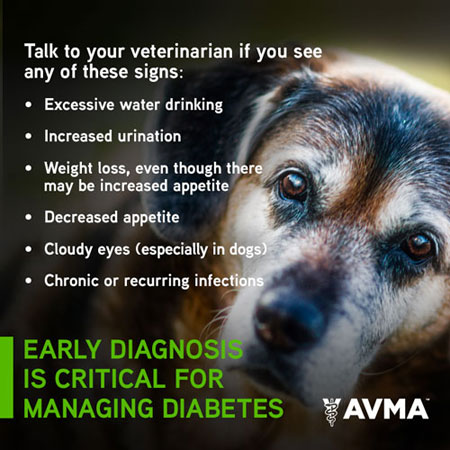
Diabetes in Pets
What is diabetes?
Diabetes mellitus, or diabetes, is a condition that occurs when the body can not use glucose (a type of sugar) normally. Glucose is the main source of energy for the body’s cells. The levels of glucose in the blood are primarily controlled by a hormone called insulin, which is made by the pancreas.
As food passes through the intestines during digestion, sugars are one of the nutrients absorbed from the food. The sugars are transported into the cells that line the intestines and are converted into simple sugars (including) glucose. The simple sugars are then absorbed into the bloodstream for circulation and delivery to the whole body’s tissues and cells. Insulin is required for the transfer of glucose from the bloodstream to the cells. If there is not enough insulin or the body is unable to use the insulin, glucose accumulates in high levels in the blood – a condition called hyperglycemia. When the blood glucose reaches a certain level, the glucose overflows into the urine (this is called glucosuria) and draws large volumes of water with it. This is why diabetic pets often drink more water and urinate more frequently and in larger amounts.
What pets are at risk?
Diabetes in dogs and cats can occur at any age. However, diabetic dogs are usually 4-14 years of age and most are diagnosed at roughly 7-10 years of age. Most diabetic cats are older than 6 years of age. Diabetes occurs in female dogs twice as often as male dogs. Certain breeds of dogs may be predisposed to diabetes.
Obesity is a significant risk factor for development of diabetes. As dogs and cats age, they may also develop other diseases that can result in diabetes or could significantly affect their response to treatment for diabetes, including overactivity of the adrenal gland in dogs (hyperadrenocorticsm) or overactivity of the thyroid gland in cats (hyperthyroidism), pancreatitis, heart disease, kidney disease, urinary tract infections and skin infections. The long-term use of medications containing corticosteroids is also a risk factor for diabetes.
What are the signs of diabetes in pets?
Noticing the early signs of diabetes is the most important step in taking care of your pet. If you see any of the following signs, your pet should be examined by a veterinarian. The earlier the diagnosis, the better chance your pet may have for a longer and healthier life.
- Excessive water drinking and increased urination
- Weight loss, even though there may be an increased appetite
- Decreased appetite
- Cloudy eyes (especially in dogs)
- Chronic or recurring infections (including skin infections and urinary infections)
How is diabetes diagnosed and treated?
Diabetes may be suspected based on the signs a pet is showing, but the diagnosis is confirmed by your veterinarian by finding consistent hyperglycemia and glucosuria. Although a diagnosis of diabetes is often relatively straightforward, your veterinarian may run additional blood tests to rule out other medical conditions seen in older pets. A urine culture might be recommended to rule out a urinary tract infection.
Once the diagnosis is confirmed, your veterinarian will prescribe an initial dose and type of insulin for your pet. Insulin cannot be given orally – it must be given by injection under the skin. Your veterinarian or veterinary technician will teach you how to give the insulin injections, which involve a very small needle and are generally very well tolerated by the pet. It is not a one-size-fits-all treatment, your veterinarian may periodically need to adjust your pet’s treatment regimen based on the results of monitoring. Dietary recommendations are an important part of treatment.
Successful treatment of diabetes requires regular examinations, blood and urine tests, and monitoring your pet’s weight, appetite, drinking and urination.
Caring for diabetic pets
Dogs and cats with diabetes usually require lifelong treatment with special diets, a good fitness regimen and, particularly in dogs, daily insulin injections. The key to managing diabetic pets is to keep your pet’s blood sugar near normal levels and avoid too-high or too-low levels that can be life-threatening. A treatment that works for one pet might not work as well for another pet, and patience is important as you and your pet adjust to the new diet and medications.
Management of your diabetic pet may include some or all of the following:
Dogs
- A high-fiber diet is often recommended.
- Daily exercise is strongly recommended. Consult your veterinarian about an appropriate exercise program for your pet, considering factors such as weight, overall health and age.
- Owners should consider spaying female dogs diagnosed with diabetes.
Cats
- A high-protein, low carbohydrate diet is often recommended.
- Daily exercise is strongly recommended, although it can be challenging to practice a daily fitness regimen with cats. Your veterinarian may be able to help you develop a plan.
It is very important to maintain the proper insulin and feeding schedules recommended for your pet. It is also very important that your pet maintains a normal appetite while on insulin therapy, or you risk hypoglycemia (low blood sugar) if your pet is not eating and absorbing enough sugars to balance the insulin’s effect of removing the sugars from the bloodstream. You will also need to regularly check your pet’s blood and urine sugar levels. Regular examinations and testing performed by your veterinarian may be supplemented by at-home monitoring of your pet’s blood and urine glucose levels at home.
Watch for the signs of an insulin overdose, which can include weakness, tremors or seizures, and loss of appetite. Contact your veterinarian or an emergency clinic immediately if you observe any of these signs, and consult your veterinarian about what you should do in the meantime to help your pet until it can be examined by a veterinarian. As signs of an insulin overdose can sometimes be very similar to signs of an insulin underdose, it is important that changes in dosage and frequency of insulin injections only be made by a veterinarian.
Because older dogs and cats are more likely to develop age-related diseases or conditions, some of which could be confused with diabetes, regular examinations by a veterinarian can keep your pet healthy and detect problems before they become severe.
If you have any questions about your pet’s health or management, contact your veterinarian.
In addition, diabetic pets should be monitored for long-term complications such as cataracts, which commonly develop in diabetic dogs and cats. Other problems that can occur include hind leg weakness due to low blood potassium (hypokalemia), high blood pressure (hypertension), or lower urinary tract infections.
Diabetic dogs and cats can live long and healthy lives with proper management and veterinary care. If you notice any changes in your pet’s behavior or weight, consult your veterinarian.




